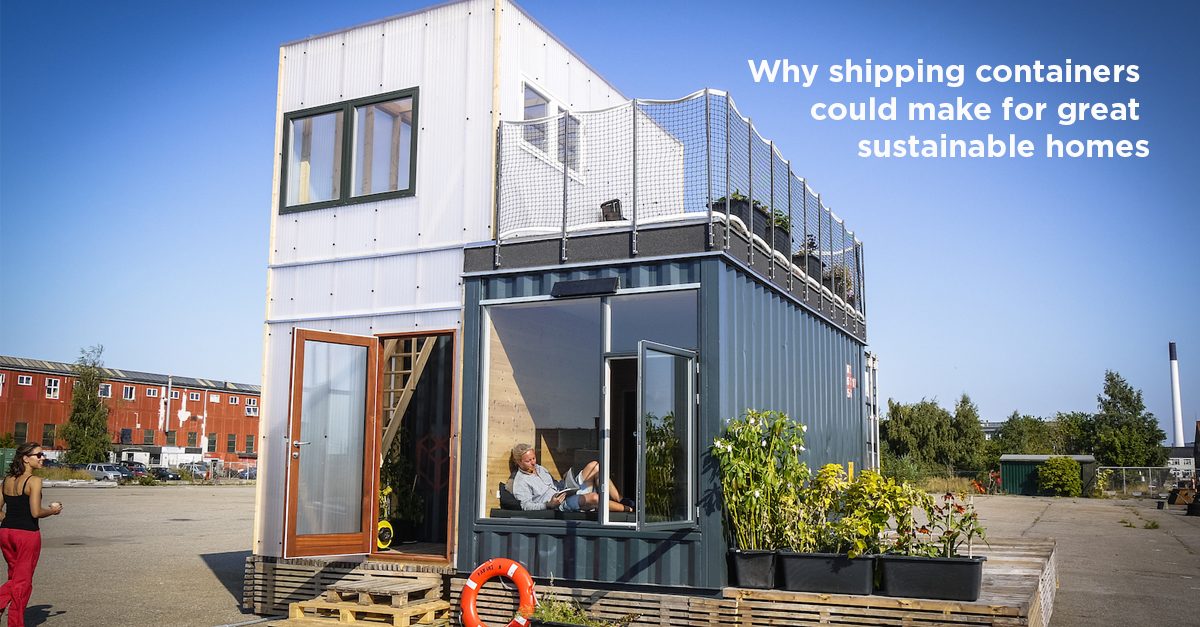Cargotecture: Why shipping containers could make for great sustainable homes
Kirsten Dirksen is a Youtuber specializing in simple, self-sufficient and small houses. Having garnered almost a million subscribers since 2006, Dirksen’s channel(1) often churns out videos on striking modern architecture keeping sustainability at the forefront. A recurring motif in her channel, since 2015, has been cargotecture, a portmanteau of cargo and architecture. So why is Kirsten’s cargotecture content gaining traction?
This form of shipping-container architecture involves the conversion of decommissioned intermodal containers into habitable spaces, and it might hold the key to the future of sustainable homes. As opposed to traditional brick and cement, shipping containers allay cost and availability concerns and boast an eco-friendly edge. The sturdy structural framework offers protection and poses no restriction on further design and customization. Sunil Gomes, CEO of Gemini Property Developers, believes repurposing an existing product opens up several new possibilities for sustainable living at a time when eco-friendliness and resource utilization have become core to business and economic wellbeing. Countless obsolete shipping containers, once destined to crumble away in remote, expansive scrap yards, can now be given a new lease of life, thanks to cargotecture.
The upside
The primary objective and design consideration of a shipping container is withstanding harsh conditions. Stacked upon one another during long cargo journeys at sea while carrying heavy loads, they are structurally sound to take that wear and tear. Many are also pre-insulated to preserve their contents. Shipping containers also offer remarkable resilience against extreme climatic conditions and fires, as well as virtually any natural calamity one can think of.
A cargotecture project is an average 30% cheaper compared to a similar project built with bricks and cement. The prefabricated exterior structure and its inherent load-bearing ability reduces the build time significantly, with interior modifications and fittings taking up most of that time. Time saving is also considerable as most structures can be assembled within a day or so, especially if all the pieces have been cut off-site (similar to prefab), with a total time of 2-3 weeks to complete a full unit. (2)
Mobility is yet another factor that makes a strong case for cargotecture. These structures can easily be dismantled into individual containers and transported, just as they would have been in the course of their original purpose. Many of the simpler but perfectly functional cargotecture projects are even devoid of a foundation, as they can be installed on any flat surface. Sunil points out that the striking, minimalist aesthetic of cargotecture, has been used very imaginatively by many architects, creating unusual but appealing built spaces that go far beyond the utilitarian approach to design. The very specific purpose and the exacting standards, to which cargo containers are built, consumes a lot of energy and resources. Sunil believes that one of the greatest benefits of cargotecture is the ability to leverage that initial input for two very different purposes, each of which can see years of use.
The flip side
Despite a laundry list of advantages, shipping containers do not come without challenges. Due to the metallic nature of the containers, temperature control remains an issue for the more plentiful non-insulated variety. In addition, metal cutting and abrasive blasting are often an integral part of cargotecture, thus necessitating skilled labour. Also, while transporting such structures is possible, it does require heavy-duty machinery and a skilled team working in tandem.
As human habitation was not a design consideration in the making of containers, the surfaces have to be neutralized of lead-deposition and chemicals, if any. Heat conductivity of metal mandates great attention towards lack of insulation and condensation build-up within the containers. Local building codes and standards have to be adhered to, and as often as not, they can thwart or at least hinder cargotecture process, as it entails the use of nontraditional methods and materials.
Cargotecture in Dubai and beyond
Since the beginning of the cargotecture movement across the UAE in 2010, the concept has come a long way, with innovative office designs, immersive retail spaces, trendy kiosks and coffee shops joining the list of the more traditional staff accommodation and warehousing options. Although shipping-container architecture was a novelty to the UAE before 2010, it has since risen in application and allure. For example, taking cues from Dubai’s popular Boxpark, an entire retail park has been created in the Emirate of Ajman, offering several retail and F&B options. Bespoke container refurbishment for events or use in sports & entertainment amphitheatres or exhibitions has also been on the rise.
Here is an excellent example of cargotectures’ social impact. In light of the refugee crisis and the living conditions of impoverished families in Syria and South Sudan, a group of pioneering architects from the Middle East proposed the construction of cargotecture-inspired housing for rehabilitation and resettlement at the Design MENA Summit (3) in Dubai. The initiative, termed as the Sheltainer Project, boasts cost-effective, respectable dwellings that offer a sustainable and low-cost solution to a critical situation.
Sunil speculates that if used imaginatively, cargotecture could also play a part in reducing urban congestion, and even alleviate the housing problems faced by millennials in many modern cities around the world, without compromising living standards. Sunil’s perspective is substantiated by the traction(4) that cargotecture is enjoying in several urban centres around the world, such as in multiple cities in Ukraine and the South Korean capital Seoul, among other global centres.
Closer to home, cargotecture has found application in a majestic stadium(5) being built on the shores of Doha, Qatar. The 40,000-seater football stadium will be one of the venues to host the 2022 FIFA World Cup, and according to the committee responsible for its design and delivery, will serve as the blueprint for a sustainable approach to future mega events. Perhaps the strongest testament to the case for the sustainability that cargotecture enables is the shipping container homes in Amsterdam featured in an exclusive National Geographic report6). The projects boast state-of-the-art amenities in tiny, economical spaces that are both lean and green. Less than a year ago, U.N. Environment and Yale University, in collaboration with UN Habitat, displayed a tiny eco-friendly home, dubbed the ‘Ecological Living Module’, that was on view at the UN Plaza(7). While the structure was not built from repurposed containers, it did showcase the burgeoning ‘tiny house’ movement that is attracting many minimalists, and those that have been priced out of exorbitant real estate markets in several countries around the world.
Sustainability
‘Green’, ‘eco-friendly’ and ‘sustainable’ have become the survival mantras for modern businesses as they struggle to balance regulatory pressure as well as millennial expectations of environmental responsibility. Cargotecture, for its part, manages to tick most boxes of an environmental compliance checklist. While this quality is mostly attributed not to the cargotecture process per se but the primary resource material – the shipping container – it can serve as a trendy, innovative and eco-friendly option for progressive builders and developers.
A trade deficit is the key reason for stockpiling of shipping containers. Most countries import more than they export, resulting in the accrual of containers. And since receiving new containers is cheaper than sending them back empty, containers are stockpiled as waste. As it stands, there are millions of decommissioned containers lying unused worldwide. Recycling would result in A colossal waste of energy, not to mention, adding to harmful greenhouse gas emissions. But repurposing them to create buildings is an elegant solution to this problem. Reusing a single 40′ container upcycles about 3500kg of steel, and helps save around 8000 kWh, which would otherwise be needed to melt it down! Additionally, using containers also prevents the use of bricks and cement, which is a big sustainability plus, as the cement industry is one of the biggest producers of CO2.
The future of cargorecture as a sustainable housing solution seems bright. Changing perceptions have meant that what was once considered housing for the poor and homeless, has now become a brilliantly innovative and ‘hot’ trendy building material that can serve as a new alternative to traditional architecture.
- https://www.youtube.com/user/kirstendirksen/
- http://www.aadhan.org/blog/2016/7/2/pro-and-cons-container-architecture
- https://www.middleeastarchitect.com/thoughts/uae-based-architects-propose-housing-solutions-for-refugees-and-low-income-families-using-shipping-containers
- https://www.progrss.com/design/20170629/cargotecture-housing-problems-cities/
- https://www.weforum.org/agenda/2018/07/shopping-mall-built-from-shipping-containers-el-paso-texas/
- https://www.nationalgeographic.com/environment/sustainable-earth/pictures-amsterdam-shipping-container-homes/
- https://www.weforum.org/agenda/2018/07/un-environment-and-yale-debut-stunning-sustainable-tiny-home-collaboration/




